A Brief History of English Fords in North America
|
By: Michael MacSems
|
The history of English Fords in North America starts with a bit of a mystery.
Ford of Canada records indicate that 205 English Ford vehicles where sold in
Canada between 1933 and 1946. There is no break out by model and we do not
know what the distribution network was. Given the small number, it seems likely
that the cars (and trucks?) were special orders for expatriate Britons.
Alternately, it is possible that some of these vehicles were simply imported for
evaluation or other in-house purposes within Ford of Canada (then located in
Windsor, Ontario). To the extent that the cars were sold to the public, they would
have the uniquely North American specification of left-hand- drive with a mph
speedometer. Has anyone ever heard of a pre-war English Ford like this?
After World War II, the British government, desperate for foreign currency,
told its motor industry to "Export or Die." Ford of Britain made good on their
obligation and had exported a million cars and trucks by 1955. This was a
quarter of all British vehicles exported during the first decade after the War.
|
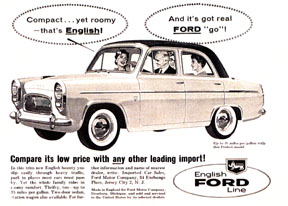
1959 Ford Prefect 100E
|
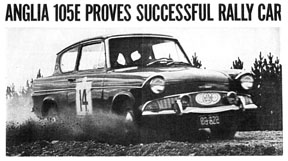
1961 Trans Canada Rally winning 105E Anglia
|
In 1948 Ford of Britain set up its North American Sales and Service (NASS)
division. Ford of Britain had high hopes for their pre-war style Anglia, Prefect
and Thames 1/4 and 1/2-ton vans. In 1948, 12,250 English Fords were shipped
to the United States, but only 3,223 (passenger cars) were registered that year
(plus another 2,025 in Canada). The fate of the remaining 7,000 to 9,000
English Fords imported that year is unclear, but auto historian Bill Siuru writes
that as a boy he can remember seeing fields full of, mainly black, unsold
Anglias and Prefects around his home town of Detroit, MI.
Still, Ford deserves credit (or blame) for being one of the first companies
to try and sell inexpensive imported cars in volume. In 1950, Ford was the best
selling import car in both the USA (1,850) and Canada (14,804). Between 1948
and 1970 Ford sold approximately 250,000 English Fords into the USA and over
235,000 into Canada between 1948 and 1973. Considering Canada's modest
population when compared to the United States, it is clear that English Fords were
considered far more mainstream in Canada than their niche status in the USA.
|
Interestingly enough, its seems that NASS was split in two (probably about
1950), with the Canadian and American operations being totally separate.
Beginning in 1951, Ford of Canada switched from advertising these cars and trucks as
"English Built" to "British- Built". Presumably this was in deference to the
large Scottish community in Canada. In 1959, English Ford operations were
reorganized in the USA as the English Ford Line and the organization behind it was
called the English Ford Line Operation or EFLO. This would be the first year
of the now famous oval (due to the racing exploits of the Cortina in 1964 and
'65) English Ford Line logo. Canada briefly adopted a modified "British Ford
Line" logo, but reverted back to the "Ford British" in 1960. The English Ford
Line and Ford British were officially absorbed into the Ford Division in 1966.
The three best sales years for English Ford passenger car in the USA were
1959: 42,413, 1958: 33,472 and 1960: 23,602. The worst year (for which numbers
are available) is 1954: 1,622. In Canada the three best sales years (cars and
trucks) were 1960: 16,360, 1950: 14, 804 and 1973: 12,783. The worst year was
1952: 1,386.
|
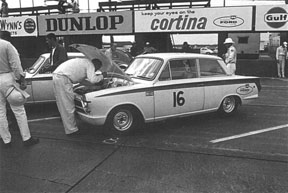
Lotus Cortinas in the pits at Sebring in 1964
|

Mr. & Mrs. Michael Schreiner of Vancouver, BC
shake hands with the staff of the Brown Brothers
Motors after purchasing the millionth export British Ford.
The Schreiner's were flown to Dagenham to take delivery of the car.
|
Until the arrival of the 105E Anglia, English Fords had no sporting
connotation in North America what so ever. However in 1961 an Anglia won the Canadian
Winter Rally and then went on to win the 11,000 miles Trans Canada Rally. In
1963, the EFLO brought three Cortina GTs to the Marlboro 12-hour races and they
placed 1-2-4. This really brought English Fords and particularly, the
Cortina, to the attention of North American sports car enthusiasts. The following two
years Ford brought over race prepped Lotus Cortinas and a line-up of top
British drivers, and raced with great results. Oddly enough, the Lotus Cortina was
only offered in the USA in 1966, with Canada also getting a handful of 1967
(Mk II) models.
|
With the advent of the Cortina, North American sales gradually improved over
the lean years of the early 1960s. The best year for Cortina sales in the USA
was 1968 with sales of 22,983 units. In Canada, Cortina sales improved year
over year until the final year of 1973 with sales of 12,783. In the USA the
Cortina was replaced by the 1971 Pinto (which sold 352,402 units in its first
year). In Canada the Cortina was replaced by the Pinto-based 1974 Mercury Bobcat,
which sold 13,076 units.
While no more English Fords were sold here after the Cortina, the
Dagenham-built Kent 1600 did return to North America as the sole engine offered in the
1978- 80 Ford Fiesta. While our Fiestas were assembled in Germany, in those pre
XR2 years the English 1600s were shipped to Sarrlouis for the exclusive use in
"Federal" spec Fiestas.
|
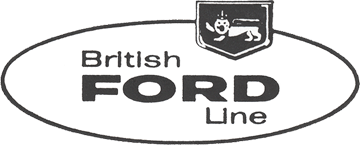
|
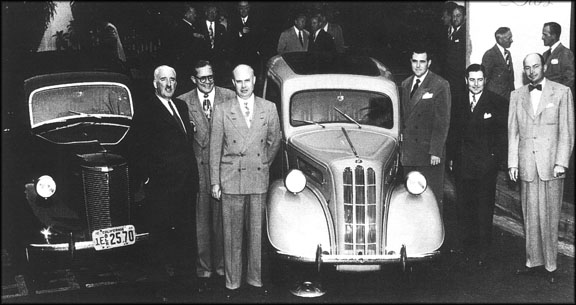
NASS sales team meeting with potential dealers in Beverly Hills, CA May 1948.
|
Article provided by The International Ford History Project
|






